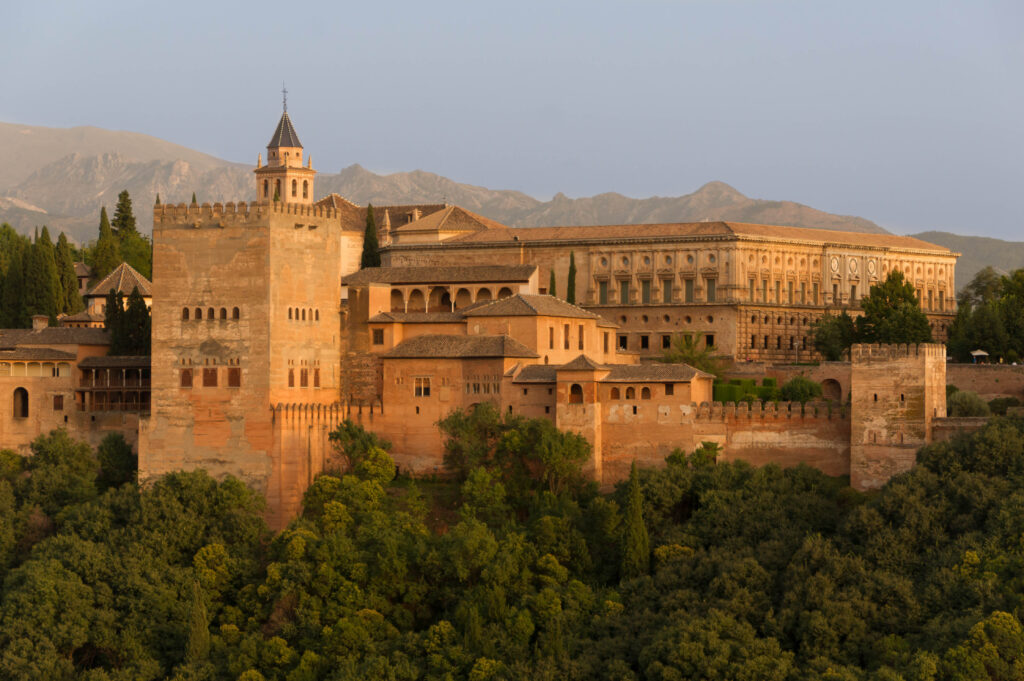From Olives to the Alhambra, Moorish Culture Takes Over Spain

By: Nissrine Bedda / Arab America Contributing Writer
From the port of Tangier, locals can see the tips of Southern Spain about thirty-five kilometers away. In the grand city of Andalusia, Spain tourists are submersed into a transnational cultural identity that opens the door to diverse artistic creativity, people, cuisine, etc. The question is, how has the port city of Tangier influenced Spanish culture being so close, yet so far? Spain’s Southern cities like Andalusia, Sevilla, and Cordoba that carry the Spanish culture that we all know like flamenco, tapas, and architecture are strongly influenced by the remains left by the civilians of Morocco’s Northern Rif cities like Tangier, Tetouan, and Chefchaouen that ruled the south of Spain for about 800 years. Today, Morocco’s Northern city of Tangier is the place that binds together the inheritors of the Moorish conquerors and the Spanish soldiers that make this city.
Remembering Al-Andalus…
Dating back centuries ago, the indigenous people of Morocco ventured out to Andalusia, Spain, The Spanish and Moroccan people have created a transnational cultural identity never seen before. The author of Performing al-Andalus, Remembering al-Andalus: Mediterranean Soundings from Mashriq to Maghrib, Jonathan Shannon, links the commonalities of Moroccan culture through style, architecture, and specifically music, to express just how dynamic these cultures are to one another. In modern Morocco, the cities of Tangier, Tétouan, Chefchaoun, Fez, Rabat, and Oujda are considered to have the strongest Andalusian heritage.
These cities are also the home of the majority of musical ensembles that specialize in the performance of Andalusian music (FN13). La Musique Andalouse Marocaine (Moroccan Andalusian Music), as it’s known in Morocco, comes from the Rif region which is the mountain range of Northern Morocco extending to Tangier. It is known that Tangier was one of the biggest ports in Africa and imported the most instruments used in European music at the time. While it seems as though Europe may have given Morocco music, Moroccans gave Spain the exquisite Islamic architecture, with almost all remains from the Moors left in the south of Spain.
Joseph Pearson, author of This is Also Tangier, gives a detailed description of Moorish architecture through an outside lens. At each end of the quadrangle I find two almost identical interiors, like those I’ve seen in religious spaces—indeed, they feel sacred. Walking inside, I look up to the intricate woodwork: cedar ornamented cupolas, and niches with hollowed-out scales. Intersecting stars are carved above, from which a trapezoidal iron lamp is suspended. I am surprised by how many geometric shapes mingle in the space, by the level of detail that never feels busy (Pearson 2018). While this description is of a mosque found in the old medina of Tangier, this is also the prime example of the beginnings of Moroccan influence through the arts that Moroccans took with them to conquer Spain in the 700s.
The creative hands of the Moors in Spain helped pave a society that was rooted by the Moroccan people yet founded upon Spanish land. The world renowned Harper’s Bazaar journal featured writer Florence Fabricant who wrote about the intermixing culture Tangier offers highlighting its history, “…al-Andalus’ is the Arabic name for those areas of the Iberian Peninsula that fell under Muslim rule beginning in the early eighth century and ending with the fall of the Kingdom of Granada in 1492 (though the Muslim presence on the Iberian Peninsula officially ended with the series of expulsions of Muslims and Jews between 1492 and 1611).” While the word al-Andulus highlights the establishment of the region, it’s up to the people to create the mixed culture between dance, like Flamenco which is rooted from the region, fish, which is common in both the port of Tangier, Morocco and Andalusia alone, the fertile land to plant olive trees and cultivated in the fields of Catalonia, etc. It’s the locals who brought up Tangier to make it the sensuous city it is today.
A Trip Down the Olive Vine
From the trip down the olive vine, Morocco’s north offers a selection of olives that are exported to Andalusia’s tapas table. A scholarly journal article written by students at the University of Cordoba mentioned in their writing, “Cordoba is an inland city of the Andalusian region and has a rich, cultural, tangible, and intangible heritage…a legacy of the Roman, Muslim, and Jewish cultures. This confluence of cultures has resulted in a pluralistic society with a mixture of traditions and gastronomy.” It’s important to highlight the Moroccan attributes that Moors have contributed to centuries ago, while they remain alive through Spanish cuisine. Olives are a staple to the tapas table and that gastronomic tradition carries on due to the olive farms found in the Southern part of Morocco. Cities like Marrakech, Oujda, and even Fez are the main regions for olive oil in the world. While Spain remains to be the first in the world to produce olives, the tradition stems from Morocco’s South.
According to a study founded by the American Society of Horticultural Science, “Olives continued to move westward into Sicily, Sardinia, Italy, France, Spain, Portugal, Algeria, Tunisia, and Morocco. It is generally believed that the Phoenicians took olives to Spain and North Africa around 1000 bce…the Iberian Peninsula (Spain and Portugal) and the north coast of Africa became large production areas of olive oil that was shipped in large amphorae to England, Germany, France, and Italy.” The story of olives marks the beginning of Moorish confrontation post-war era for Spaniards, and the journey of trade and diplomacy remains for Spain and Morocco to this day.
Morocco’s North is what has tied two countries together for hundreds of years. Whether through conquest or through sharing recipes, two countries with the longest history have come together through gastronomy, architecture, and music. While they may not have begun off at the right start, their families have paved a way to reunite in today’s world with open arms to invoke connection through learning from one another. And this story of a strong bond between these two countries today is just one more chapter to include in the history of Moorish culture in Southern Spain. It’s up to the one’s foreign of this bond to visit Tangier to see it for themselves.









